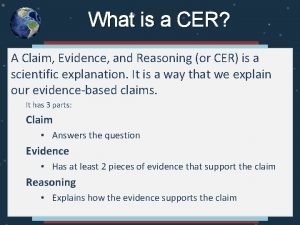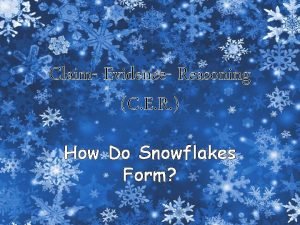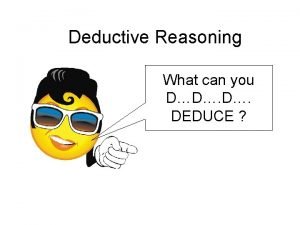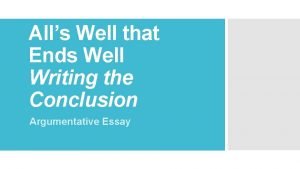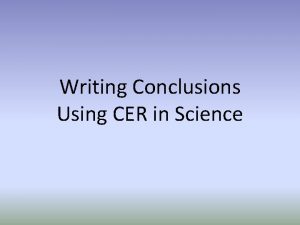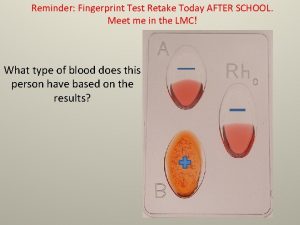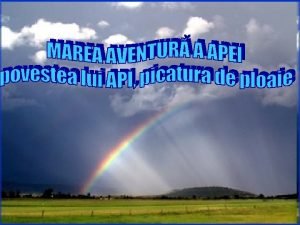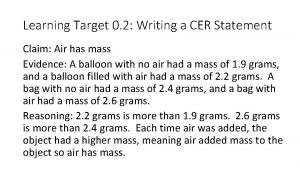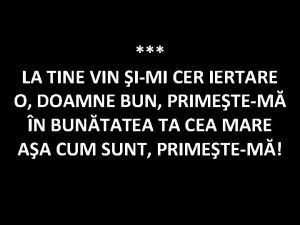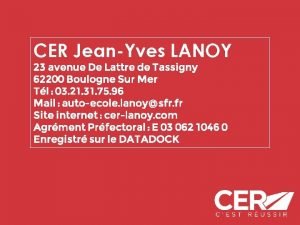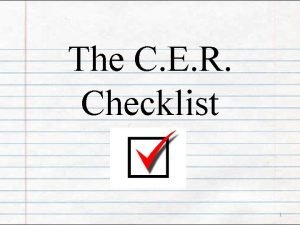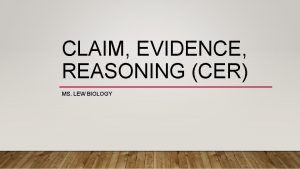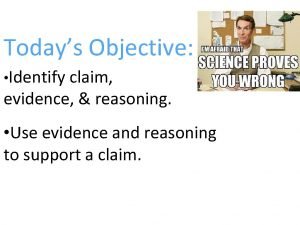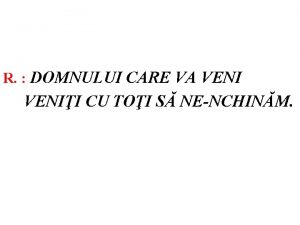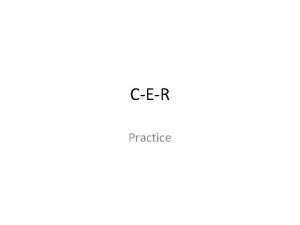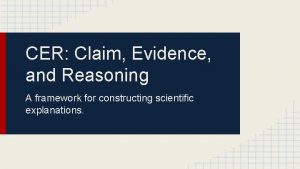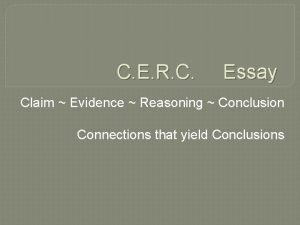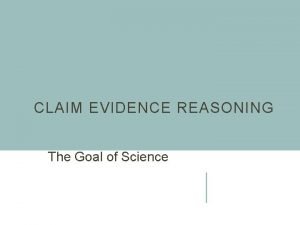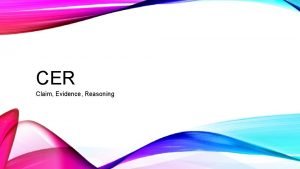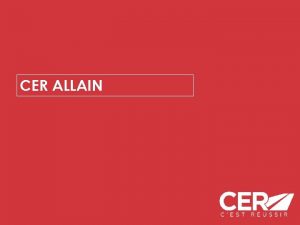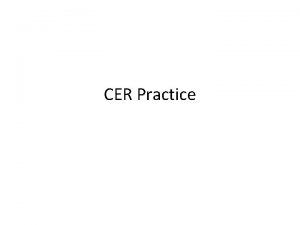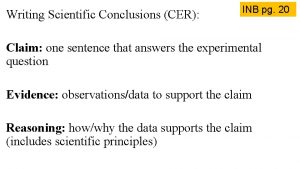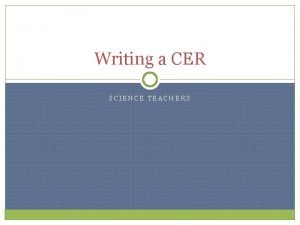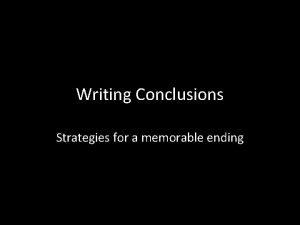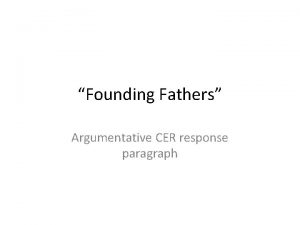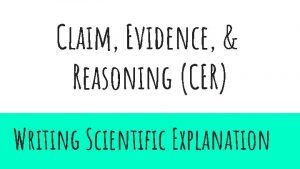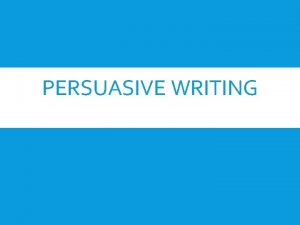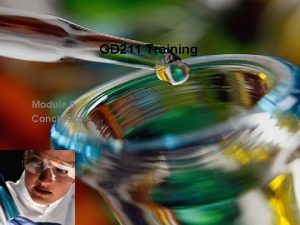Writing Conclusions Using CER in Science Writing Conclusions






















- Slides: 22

Writing Conclusions Using CER in Science

Writing Conclusions Using CER in Science

What are the parts of a Conclusion? • CLAIM • EVIDENCE • REASONING or…. CER

CLAIM • A statement about the solution to a problem • A response to a question • An answer to a problem

EVIDENCE • Relevant data or facts that supports the claim • Observations that support the claim

REASONING • Explains how the evidence is linked to the claim • Tells why the data, facts, or observations support the claim • Shows an understanding of evidence by telling why science explains the results.

What do you claim happened? What evidence supports your claim? What reasons do you have for connecting that specific evidence to your claim? My dog ran away. There’s a loose plank and a hole under the fence. My dog’s chain is broken. Since my dog is not on the end of the chain, he is small enough to fit through the hole in the fence, and he is strong enough to break the chain, I conclude that he must have ran away.

Question: What type of flowers are best for a butterfly garden? Investigation: We planted four different types of flowers and recorded how many butterflies landed on each type of flower.


Claim: Butterfly gardens should include orange flowers. Evidence: We planted of different colors in our garden. More butterflies landed on the orange flowers than any other flower. Reasoning: We researched and found out that most butterflies like bright colored flowers. Our zinnias were bright orange and the butterflies liked them better than the yellow and white flowers we planted. Yellow and white are not bright colors so the butterflies were not attracted to them. Therefore, butterfly gardens should contain zinnias or other flowers that are brightly colored.

Claim: Butterfly gardens should include zinnia flowers. Evidence: We planted 4 types of flowers in our garden. More butterflies landed on the zinnia flowers than any other flower. Reasoning: We researched and found out that butterflies really like flowers with a lot of nectar. Our zinnia flowers are very high in nectar so the butterflies were attracted to them for food. Also, most butterflies like bright colored flowers. Our zinnias were bright orange and the butterflies liked them better than the yellow and white flowers we planted. Therefore, butterfly gardens should contain zinnias or other flowers that are bright and have a lot of nectar.

Let’s Practice with a Force and Motion Example…

Let’s Practice We rolled a car down two ramps that were at different heights. Our question was “Does the height of a ramp affect the distance an object will roll? ” Our data is below: Height Trial 1 of Ramp 90 cm 5 cm 98 cm 99 cm 96 cm 10 cm 188 cm 180 cm 184 cm 185 cm Trial 2 Trial 3 Average What claim can you make?

What is the Evidence? Use the information from your data table to support your claim.

Explain your Reasoning • Show your understanding science to explain the results • Use what you know from science to explain your thinking. Support your reasoning with scientific words such as gravity, force, speed, distance, etc.

Now it is your turn! What question do you think the researcher was asking? Type of Surface Trial 1 Trial 2 Trial 3 Average Tile 183 cm 189 cm 190 cm 187 cm Sandpaper 60 cm 59 cm 52 cm 57 cm Astroturf 20 cm 25 cm 22 cm • Write a conclusion that includes a claim, evidence, and reasoning. • Check your work to make sure your message is clear and that you used correct spelling, grammar, and punctuation.

Remember… • Scientists have to convince people that their research is correct. • They do this by stating their claim and supporting it with evidence. • Then the scientist teaches the reason it happened that way using scientific principles. And that is the C-E-R way!

Rubric Which May Be Used to Grade Your Conclusions:

Examples of CERs



Is blubber an insulator or a conductor? Blubber is an insulator. When we placed our hands into ice water, the one that had the “blubber glove” around it did not get as cold as fast as the one that just had the plastic and air around it. Insulators are things that keep energy from passing through them. The blubber keeps the cold from getting to our hand it keeps the heat from our hand from going into the cold water.
 Claim, evidence, reasoning example paragraph
Claim, evidence, reasoning example paragraph Science cer sentence starters
Science cer sentence starters The process of using logic to draw conclusions
The process of using logic to draw conclusions Mathematics ____ my favorite subject.
Mathematics ____ my favorite subject. How to write a conclusio
How to write a conclusio Conclusions for informational writing
Conclusions for informational writing Cer conclusion example
Cer conclusion example Cer examples
Cer examples Floare albastra explicatia titlului
Floare albastra explicatia titlului Claim evidence reasoning sentence starters
Claim evidence reasoning sentence starters Naframa vargata peste mare-aruncata
Naframa vargata peste mare-aruncata Cer statement
Cer statement La tine doamne vin mereu
La tine doamne vin mereu Cer lanoy dernier sous
Cer lanoy dernier sous Cer checklist
Cer checklist Slip or trip claim evidence reasoning answers
Slip or trip claim evidence reasoning answers Shamwow cer
Shamwow cer Va venii sau va veni
Va venii sau va veni Cer sorting company
Cer sorting company Cell theory cer
Cell theory cer Are soap and fat the same substance
Are soap and fat the same substance Claim evidence reasoning essay
Claim evidence reasoning essay Shamwow cer
Shamwow cer
